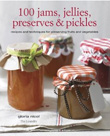MAKING EVERY HOT BUN A HAPPY BUN
Thursday April 21st 2011, 3:34 pm
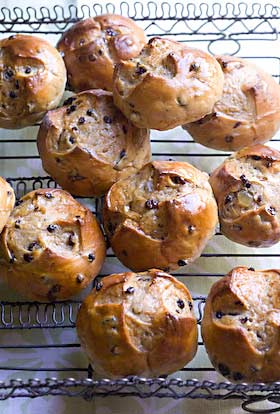
Whilst once upon a time hot cross buns only turned up in the shops just before Easter, they can now be bought any old time. So one-a-penny, two-a-penny, hot cross buns are now ten-a-penny, having lost their seasonal specialness. I try each year to make my own, even if it is only just once and the buns turn out far superior to anything shop bought. Even using mixed spice from an old packet that has sat in the cupboard for just about forever, you make a better bun. But it is only when you actually grind and blend the spice mixture yourself, moments before baking, that you learn to appreciate what a difference really fresh spices make to the taste. With a comparative whiff of your own fresh and zestful mixture alongside an already opened packet of the shop-bought sort, it is blatantly obvious that one is doing a merry dance with the occasional pirouette whilst the other is wearing misshapen Ugg boots and dragging its feet in a slovenly fashion.

It really is worth taking a little extra time to grind your own spice blend. Use whole spices that are as fresh as they can be, but even with whole spices you’ve had a while, if you grind them yourself just before you need them, they’ll will have bags more flavour than ones already ground that have sat on the supermarket shelf for who knows how long.
I do have an old Moulinex grinder somewhere that I use just for grinding spices but haven’t a clue where I’ve put it, and am certainly not prepared to allow my coffee grinder to be tainted with spice. So on this occasion I pounded and ground the spices by hand with a pestle and mortar, which is a job I very quickly tire of, but I got the result I wanted in the end. I do think some help from an electrical appliance is the best option.
If you use lots of mixed spice, you’ll be able to adapt the blend to suit your own tastes and tweak the amounts accordingly. Can’t say I’m that tuned in to it yet, but here is the blend I made for my hot cross buns that I am very satisfied with. Perhaps next time I’ll try a bit more cardamon and add some fennel seeds as well. I didn’t have a cinnamon stick so did add my cinnamon and ginger ready ground.
MIXED SPICE
2tsp whole allspice
1 1/2 tsp whole cloves
2tsp freshly ground nutmeg (probably best to grate it separately first)
2tsp ground ginger
2tsp ground cinnamon or ground fresh from a cinnamon stick
1/2 tsp coriander whole seeds
4 blades of mace, broken up
seeds from 4 cardamon pods
Grind them all together to a fine powder. Keep in a well-sealed jar and label with the date.

I’m not partial to tasteless flour paste crosses on my buns though can appreciate the tidy result. I cut my crosses with a razor blade just before the risen buns went in the oven and this gives a much more haphazard, somewhat charming homemade look. You can of course make them non-denominational if you prefer and dispense with the cross altogether.
HOT CROSS BUNS
Makes 16 buns
500g strong white flour
7g packet of fast acting yeast
60g soft brown sugar
2 heaped tsp of mixed spice
1 tsp salt
60g butter, melted
1 egg, beaten
grated zest of 1 lemon (optional)
60g candied peel **
250ml milk, slightly warmed
120g currants
For the sticky glaze:
2Tbsp sugar
2Tbsp water
Place all of the ingredients except the currants in a food mixer with a dough hook and mix to a sticky dough for 5 minutes. You can of course use a bowl and combine by hand, but the mixture is quite soft and sticky. Add the currants and stir them through the dough. Cover the bowl with a tea towel and leave in a warm place for a couple of hours or a cold place for 4-6 hours until the dough has more than doubled in size.
Punch the dough down and empty the bowl’s contents onto a floured board then knead it for 2 minutes, incorporating more flour if needed to make a manageable, smooth dough. Form the dough into an even circle, cut into 4 equal pieces then cut each of these quarters into 4. Form each piece into a bun shape and place with some space between, on greased baking trays. Cover with tea towels and leave to rise and double in size. This will take as little as 30 minutes in a warm kitchen, or a couple of hours in a cool room.
Pre-heat the oven to 220C (425F, Mk7). Slash a cross in the top of each bun with a sharp knife or blade just before they go in the oven. Bake the buns for 15 minutes until lightly browned. Remove from oven and whilst hot brush generously with sugar glaze. To make this, dissolve the sugar in the water in a pan and bring to the boil.

** I didn’t have any candied citrus peel in the house so used some candied melon peel, which gives texture, but without the tang, so then added 2 Tbsp chunky cut marmalade to the mixture as well. (I’m telling you this, not to confuse you but to encourage you to make things up as you go along!)
A SEED PLANTING MASTERCLASS
Saturday April 16th 2011, 11:48 am
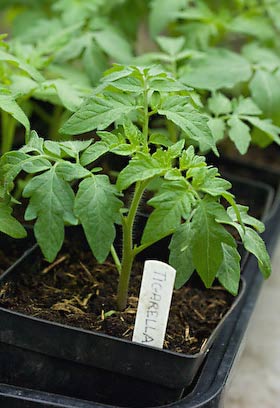
Well this week I managed to get my asparagus bed planted, which felt like no mean feat. The soil needed a lot of attention and I took great care to remove any perennial roots I could find as I sifted through it, as all the books tell you you must. When the asparagus crowns were safely in their straddling positions and covered with earth, instead of feeling a great sense of achievement I was positively down in the dumps; only 2 more years to wait for a crop. Whoopee, roll on 2013! By then I’ll be two years older but hey, I’ll be eating my own homegrown asparagus. I don’t seem to have quite the right attitude, do I?
Anyway, what next? Time to plant some seeds to fill in the gaps around my fruit bushes. I love buying the packets with inspiring pictures of my prospective crops on the front, but you really do have to get them in some compost as they don’t do that themselves. I decided to go visit my friend Shelley, who is a brilliant gardener and font of horticultural knowledge, for a masterclass in seed sowing. She will surely give me the inspirational uoomph I seem to be currently lacking to restore my gardening mojo.

Shelley is really into growing veg. She grows some for her local show and the competitive bug has well and truly taken hold. Her garden is set out in quite a formal way, with geometric shaped raised beds all working towards central focal points, in the style of a classic parterre with finials on every corner. There is a four sided regency arch with a chandelier hanging from the centre which will soon have sweet peas and climbing beans scrambling over it. The difference with Shelley’s planting style is that she fills the beds with vegetables and uses them in a decorative way. So instead of the beds being edged with box hedging, she uses broad beans with green stakes, or leeks growing for showing in terracotta tubes. Each year the planting changes as the crops rotate. She starts her potatoes off in small pots of compost then plants them as part of the pattern, planting and earthing up in one fell swoop. The soil looks amazing and she is the best person I know to consult when I want to know just what particular element a certain crop will need, beit more nitrogen or a little potash to get the best results.

First she showed me some seedlings that she hadn’t grown from seed. Both of us seem to have arrived at the point where we have realised it can be unproductive to want to grow absolutely everything. Sometimes being over ambitious can be a problem. Though we both share a love for unusual plant varieties we’ve concluded it’s better to grow a good classic, great tasting spud than some weird purple sort that only looks good in a photo. There is always room for experimentation but the best flavoured crops are now a priority. Shelley has some dill seedlings that were bought as one pot from Homebase which she then split to make six very healthy looking plants. That would suit me fine too. I need some dill for my pickling, so this would also work well for me. No need to always invest in a whole packet of seed.

Next she planted up a tray of her special Serbian pole beans. She’d been given this bean some years ago and saves more seed each year. This bean apparently has a very fine flavour, can be eaten fresh but stores well when dried. Perfect for my preserving garden. The compartments of a recycled seed tray were filled with Shelley’s specially mixed seed compost and a bean was pushed into each one, covered with a bit more compost, et voila, that was easy enough.
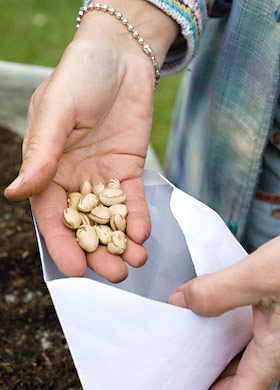
Shelley showed me her trick for broad beans, where she germinates the beans in a plastic bag partly filled with compost, just throwing her handful of beans inside, tying the bag and placing it by her Rayburn for a few days. It is also a good way of testing the viability of the seed if it has been hanging around for a while. This means that only germinated seeds get planted and avoids any gaps in the rows that you sometimes find when planting straight into the ground.
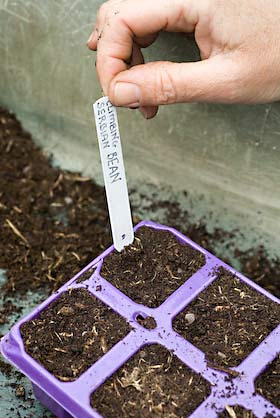
Seeds that traditionally would be sown straight in the ground and resent root disturbance can still be started off in pots, but for these a biodegradable pot works best. Beetroots and parsnips fit into this category. Shelley had some paper pots already made from newspaper for this job using a paper potter. The beetroot seeds contain several seeds in a cluster, so it is only necessary to put one seed per pot. By the time they are ready for planting out the newspaper will easily disintegrate and allow the roots to work their way out into the surrounding soil.
As the rows of seeds were sown each was labeled to avoid any confusion later on. All the seeds were lightly covered with compost except some romanesco brassica seeds that like to be planted on the soils surface. For these a light sprinkling of vemiculite neatly finished them off. All the seeds were given a sprinkling of water from the watering can then placed out of the way to germinate, in Shelley’s case on a shelf in a cold greenhouse.

So spurred on I set of back home, my tray of Serbian pole beans on the car seat beside me as well as a globe artichoke plant and a bunch of freshly picked lovage. I’m now feeling full of enthusiasm to get planting. As Shelley opened the gate for me to drive away, I thought I’d give something back in return and handed her a very healthy looking Jerusalem artichoke that just happened to be sitting in a bag in the car, recently collected from someone on Freecycle, who had offered them for free. They are the plumpest, healthiest artichokes I’ve ever seen in my life! Shelley was also suitably impressed with their quality and happily accepted my gift. That’s the great thing about gardeners, simple things can mean such a lot.
RHUBARB FLOWER SPOTTING
Friday April 08th 2011, 4:09 pm

Everybody’s rhubarb seems to be going to pot round here, going to seed and throwing up flower heads. Any rhubarb lover worth their salt will of course cut them off as soon as they appear so as not to exhaust the plant, like I showed in my last post and also wrote about here. Some people just don’t care and leave this vegetable to do its own thing. I must admit I love the sight of towering rhubarb flowers but love the taste of rhubarb more (this is starting to sound like a Harry Hill ‘F-I-G-H-T’). As I’ve got big preserving plans for my own homegrown rhubarb I am happy to leave the flower cultivation to others.
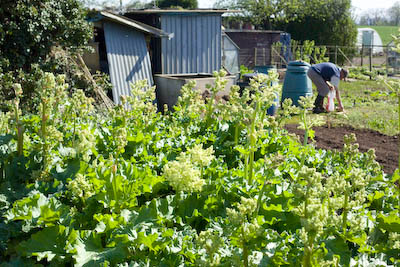
I have often noticed some rhubarb growing on an allotment in the village. It forms a particularly lush band going right across the width of a plot. Today I saw that it was all in flower so decided to stop to take some pictures. The old guy whose plot it is, thought I had stopped to request some rhubarb, as he doesn’t eat it! He said he sowed a packet of seeds three year ago, a variety of which he had no recollection, and this is what resulted. As far as he was concerned he’d be happy to get rid of the lot.
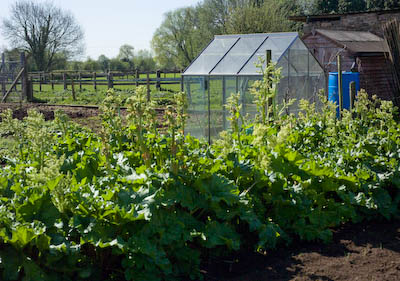
I have seen the flowers on sale in London as a cut flower. Can’t imagine them being popular round these parts but it’s a shame as the flowers, though strangely triffid-like, are rather grand and statuesque. I cut one off a plant in my garden and have it currently on my mantelpiece as a cut flower in a vase. They are big heavy blooms with hollow stems and like other cut flowers with hollow stems you need to hold them upside down and pour water into them till full, then bung up the end with a piece of cotton wool, before returning to upright and placing in a good heavy, topple-proof vase filled with water. The flower seems to be continuing to grow day by day, which is rather spooky.







